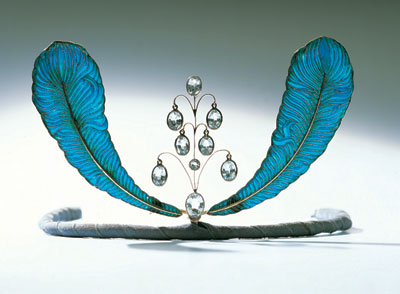Set of two Meiji tortoiseshell kanzashi with plovers on them. The last two shell kanzashi I bought arrived broken. Let’s hope the third one’s the charm! lol I paid a whopping $77 for them on ebay. I love the seller, though. She’s a superb collector.


Set of two Meiji tortoiseshell kanzashi with plovers on them. The last two shell kanzashi I bought arrived broken. Let’s hope the third one’s the charm! lol I paid a whopping $77 for them on ebay. I love the seller, though. She’s a superb collector.

All the artists who made these combs, c. 1800, are unknown. The first is carved and incised ivory with openwork, showing two cranes pointing at a family crest, which in Japanese is called KA-MON. KA means families with their own genealogical trees, and MON means crest.
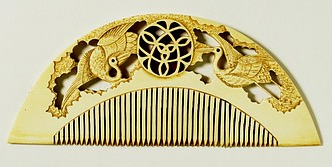
The second comb is made of tortoiseshell, graced with cream and red lacquer. The artist painted two plover birds flying to a rest spot on a bamboo tree branch. The two points of interest are on the sides of the comb: the left edge shows the birds, while just to the right side, lined up with the tines, a red bamboo trunk waits for the birds to land on its branches.
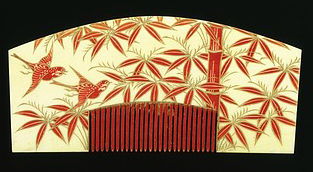
Third, is a square tortoiseshell comb with several floral gold maki-e designs.
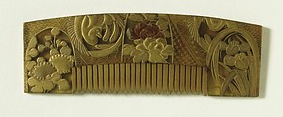
Last but not least, is a grey half-moon-shaped comb showing a mother-of-pearl half moon shining amid a sky of gold stars and chimeras.
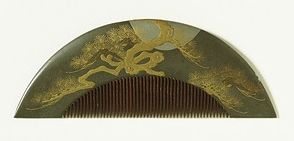
All four combs reside in the Victoria and Albert Museum in London.
First, Rene made a simple horn comb. Then he attached a gold medallion with inlaid mother-of-pearl clovers. He elongated the horn on the top-right to frame a real peacock feather. To hold the feather in place, he carved and attached a magnificent gold bird, with its royal plumage of peacock feathers carved in gold flowing over the tines. What a beautiful idea of both art and engineering. c. 1902-1903.
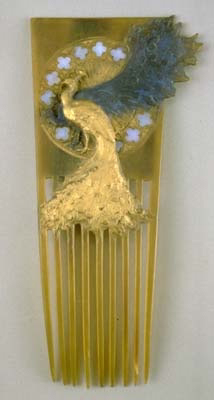
Another peacock dream Rene had was this pectoral. Usually associated with ancient Egypt as a medallion attached to a necklace, or a brooch, I think this piece could easily function as a barrette. Using the Symbolist philosophy of Art Nouveau, the peacock and its feathers are done in blue and green enamel accompanied by randomly set cabachon opals. Diamonds bookmark the piece. c. 1902-1903.
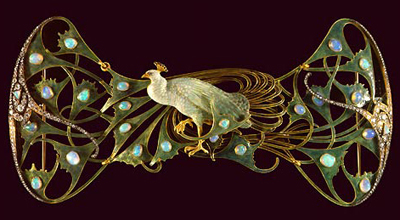
C. 1850, this tiara’s wreath boasts seven graduated oval-shaped sapphire and diamond flowerheads. They rest on a rose-cut diamond branch. In the middle is the most elaborate flower and largest sapphire. Last summer, it sold for $100,144 in London.
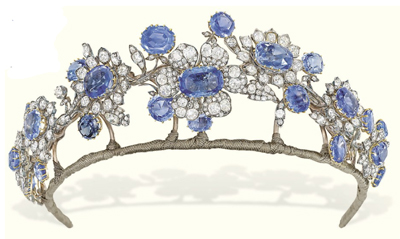
Sometimes tribal artists can grab your eyes to look at and understand their ancient worlds. This whale-bone comb from the Tanimbar Islands in the Maluku Province of Indonesia dates back to the 1900s, as the patina shows. The head figure on top looks like a god resting on the pedestal of the comb, although I cannot be sure. I just liked it, so I made a low-ball offer. It was accepted, and I bought it. Sometimes, I see things in tribal art. I buy on instinct.
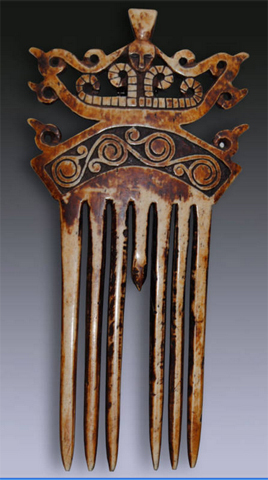
Rene Lalique made a comb he called, “Bats.” I did a collection of combs with rats and bats on them, I guess this was his entry into rodent life. :-) They are made of blue enamel on a horn comb.

This next one could not be more of a contrast. It’s a tiara of gold, enamel, and sapphires hinged to a horn comb, which a lady would wear to the opera to highlight a sumptuous blue gown. c.1902 – 1903. The comb resides at the Museum of Fine Arts in Boston.
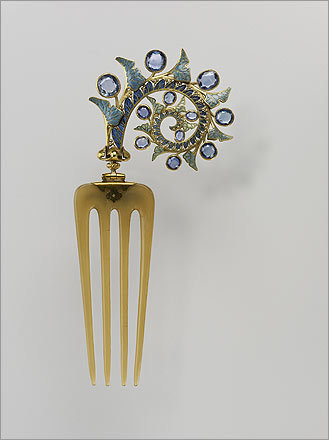
Had to. It had ballies on the end of it. It is stamped Dominick & Haff, an American silver company, 1871, 100% Sterling. The design is quite unusual. I wanted it. C’est la vie.
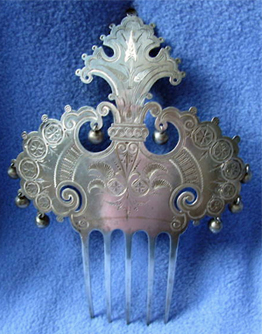
This comb comes from the Solomon Islands of Australia. Its curve was made by a flattened hand. Twenty-five dark-brown tapered wooden prongs form the teeth. The top is held together with thin strings of woven plant fiber, creating compatible red and yellow geometric patterns. There are no religions or hierarchies in this piece.
Great artists make things from what they see in their world. You can look at a comb and understand what kinds of lives they lived.
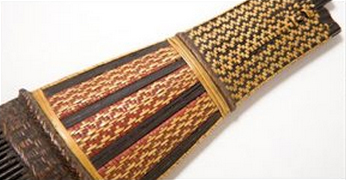
Best known for its British Arts and Crafts and Art Nouveau jewelry, this firm opened in 1880, producing neo-Renaissance pieces. From 1891 – 1916, the imaginative, bright enamel work on their peacock, wing, and insect designs won them Royal patronage. In 1916, the firm closed.
This piece, which is signed, might be part of their earlier work. Hinged to a tortoiseshell comb, the silver tiara is laced with garnets. What I love about it though is the hat on top with its ribbons flowing through silverwork. It sold at Sotheby’s for 1350 UKP.
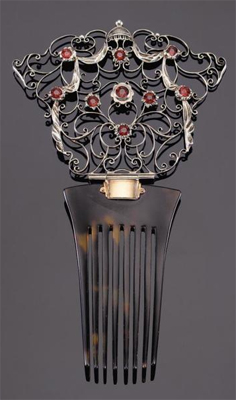
However, when Child & Child’s artistry became revolutionary, one of their most famous pieces was a tiara of two bright blue enamel peacock wings, which sold at the Tadema Gallery in London. I know the price range was over 20,000 UKP, but I cannot imagine the exact, final price.
